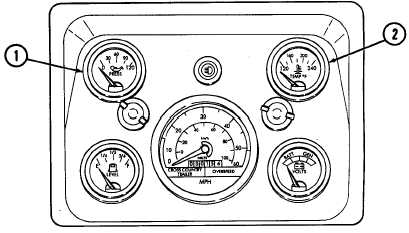TM 9-2320-280-10
2-144
Change 1
c. During Operation.
CAUTION
Avoid continuous vehicle operation at high speeds. Avoid long hard
pulls on steep grades with transfer case shift lever in “L” (low range)
position. Damage to transfer case will result.
(1) Frequently check coolant temperature gauge (2) and oil pressure
gauge (1). Engine is overheating if one or more of the following conditions exist:
(a) Engine coolant temperature is more than approximately 230°F
(110°C) as indicated by temperature gauge (2).
(b) Engine oil pressure drops below approximately 15 psi (103 kPa) with
engine under a load.
(c) Engine oil pressure drops below approximately 6 psi (41 kPa) with
engine at idle.
2-35. OPERATING IN RAINY OR HUMID CONDITIONS
a. General. Material inactive for long periods during rainy or humid
conditions can rust rapidly. Fungus may develop in the fuel tanks as well as on
soft tops, seats, and other components. Frequent inspections, cleaning, and
lubrication are necessary to maintain the operational readiness of vehicles.
(2) If engine overheating occurs:
(a) Park vehicle, allowing engine to idle.
(b) Observe coolant temperature gauge (2) for steady cooling.
CAUTION
• Stop engine if coolant temperature gauge suddenly increases
beyond approximately 230°F (110°C). Failure to comply will
result in damage to engine.
• Notify unit maintenance to check differential, T-case, and
transmission fluids for “oil breakdown” caused by overheating.
(c) If engine coolant temperature continues to increase or does not
lower, stop engine. Perform troubleshooting procedures in table 3-1.

